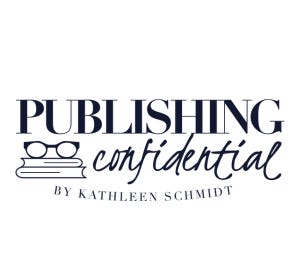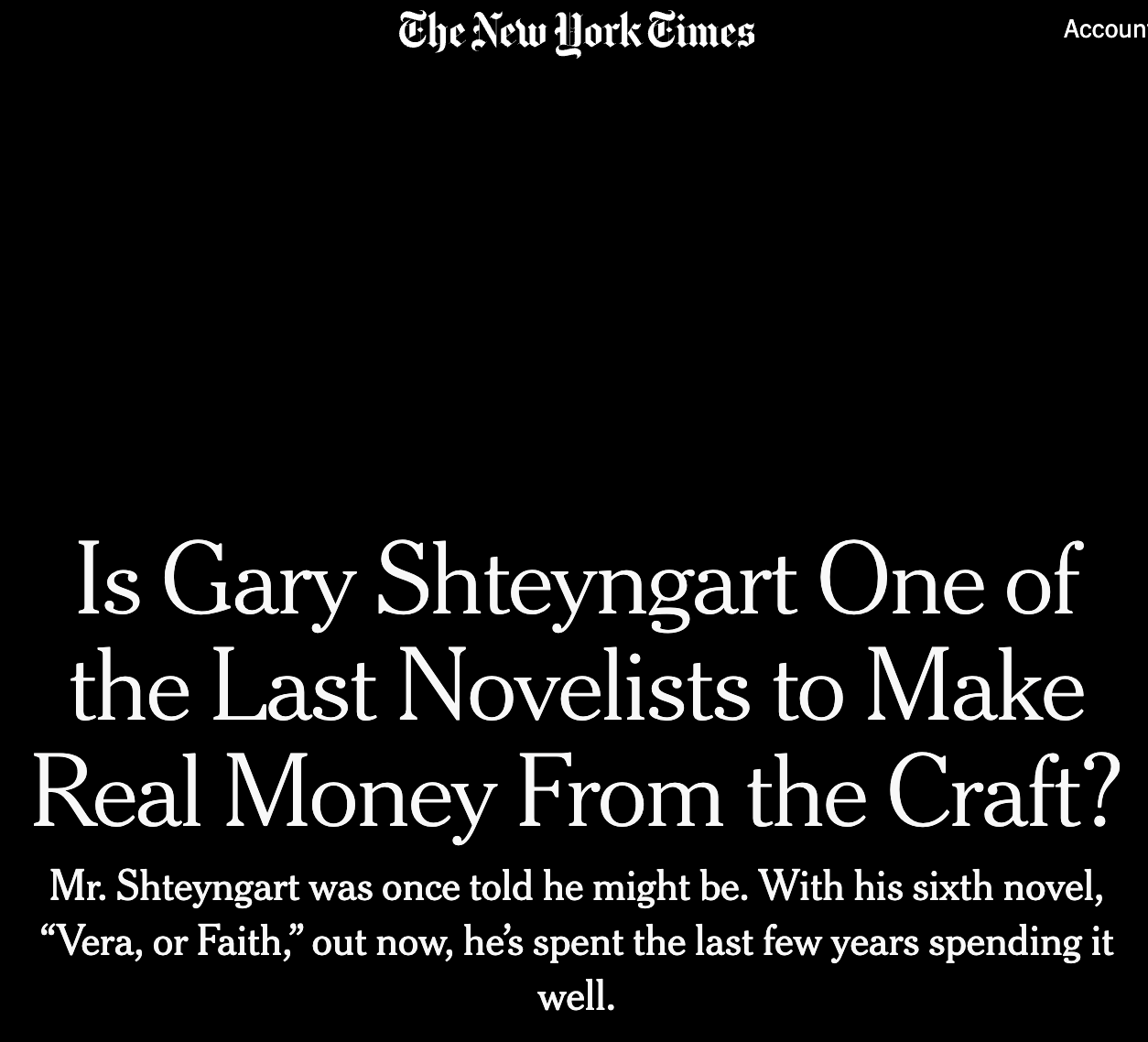The Novel is Not Dead
David Brooks would like us to think it is. Plus: Is Gary Shteyngart really the last novelist making "real" money? And is the straight white man's novel dead, too?
I have THREE spaces left in my author branding class. Scroll to the end for details!
A clear sign that it’s a slow news cycle for publishing is when the media attempts to write various obituaries for the publishing industry. It seems that The New York Times has taken up a new cause this summer: the death of the novel, male authors who make money, and men who don’t read. Let’s unpack what’s happening.
The Novel is Not Dead
This week, New York Times opinion columnist David Brooks wrote a piece entitled "When Novels Mattered." In it, he reminisces about a time when literary fiction was allegedly thriving more than it is today.
He writes:
In the mid- to late 20th century, literary fiction attracted huge audiences. If you look at the Publishers Weekly list of best-selling novels of 1962, you find works by Katherine Anne Porter, Herman Wouk and J.D. Salinger. The next year you find books by Mary McCarthy and John O’Hara. From a recent Substack essay called “The Cultural Decline of Literary Fiction” by Owen Yingling, I learned that E.L. Doctorow’s “Ragtime” was the best-selling book of 1975, Roth’s “Portnoy’s Complaint” was the best-selling book of 1969, Vladimir Nabokov’s “Lolita” was No. 3 in 1958 and Boris Pasternak’s “Doctor Zhivago” was No. 1.
Today it’s largely Colleen Hoover and fantasy novels and genre fiction. The National Endowment for the Arts has been surveying people for decades, and the number who even claim to read literature has been declining steadily since 1982. Yingling reports that no work of literary fiction has been on the Publishers Weekly yearly top 10 sellers list since 2001. I have no problem with genre and popular books, but where is today’s F. Scott Fitzgerald, William Faulkner, George Eliot, Jane Austen or David Foster Wallace?
Does Mr. Brooks read his newspaper’s book coverage? If he did, he’d know that literary novels like The Emperor of Gladness by Ocean Vuong, Dream Count by Chimamanda Ngozi Adichie, and We Do Not Part by Han Kang are alive and well—and being widely read. Also, it is not a crime to read Colleen Hoover, romantasy, or genre fiction. People are reading. That’s what matters.
Do we need a modern version of F. Scott Fitzgerald, William Faulkner, or Jane Austen? I don’t think so. Publishing is a business, and while prestige publishing still exists (like Knopf books), books must sell for publishers to remain profitable. Commercial fiction is an integral part of that plan. It doesn’t mean literary fiction isn’t and can’t be profitable, but one glance at bestseller lists will show you that the books selling well have broad appeal. Conversely, literary fiction appeals to a slightly smaller sector. It has been this way since I began my career in the business 30 years ago.
Mr. Brooks goes on to say, “It’s just that interest in contemporary writers overall has collapsed.” This is simply untrue. Then again, if you lean conservative as Mr. Brooks does, you’re probably not looking for books by non-white literary writers. He’s telling on himself a bit here:
Furthermore, the literary world is a progressive world, and progressivism — forgive me, left-wing readers — has a conformity problem. Even more than on the right, there are incredible social pressures in left-wing circles to not say anything objectionable. (On the right, by contrast, it seems that you get rewarded the more objectionable things you can say.)
Progressives do not overpopulate the literary world. Most people I know in the industry lean left, but not so far as to be overly radical. Left-wing readers don’t have a conformity problem. Instead, they, and many others, dislike cultural appropriation in books. While I generally disagree with most pearl-clutching over books in the industry, I also understand broader consumer trends, which Mr. Brooks seems to look down on. I suppose he won’t be reading Rebecca Yarros anytime soon.
Is Gary Shteyngart the last novelist making "real" money?
Did we really need to know about Gary Shteyngart’s penchant for expensive watches? I don’t think so. He gave himself a makeover and is now what I would refer to as a “Dandy.” Trust me, it tracks. While I have nothing against Mr. Gary Shteyngart, I do take issue with this headline:
And this paragraph received an eye roll from me:
Writers do not occupy the role in society they once did when Mr. Mailer held court at New York’s popular literary and celebrity hangout Elaine’s. Attention spans vanished. So did advances. Mr. Shteyngart recalled a “many martini lunch” with the Random House editor Daniel Menaker. “You’re one of the last people that’s going to make any money off this,” Mr. Menaker predicted.
Call me crazy, but I don’t think Norman “I stabbed my wife” Mailer is the best example here. Thank goodness society changed, because now women are “making real money” as authors. I don’t think Emily Henry, Taylor Jenkins Reid, Sally Rooney, and others would agree that one male author is one of the last people who is going to make money writing books.
The Death and Life of the Straight White Man’s Novel
Straight white male novelists ruled the publishing roost for years, so this article in The New York Times confounded me. There are plenty of straight white male novelists. Some of them haven’t written books for a long time. Jeffrey Eugenides, Jonathan Safran Foer, and Jonathan Franzen—the holy trinity of male authors in the early aughts—haven’t published new books for a few years. Still, they aren’t the end-all be-all of literary fiction. A quick scroll through this list of the best books of 2025 so far, NPR proves that quite a few male novelists are writing terrific books. Are they white and straight? Who cares? A good book is a good book, and straight white male novelists have overpopulated the literary community for a long time. I’ve worked with many of them during my 30 years in the industry. Times have changed with the rise of romance and romantasy, and the majority of book buyers are women. Are we supposed to apologize for what female consumers want to read? I think not.
I have a theory about why female authors have become more prominent: the majority of them are better at social media, and therefore better at self-promotion. They excel at creating a community around their books. Straight white male authors could learn a thing or two by watching their female counterparts. Instead, many of them scoff at the notion that one needs a platform. Scoff all you want, but a platform is necessary to connect with readers.
The real question worth asking is, why aren’t more straight white men reading female novelists? I’d love to know.
END NOTES:
What I’m Watching: If you’ve read this newsletter long enough, you know that my 17-year-old daughter is my TV watching buddy. We’re currently watching Building the Band on Netflix. The concept is that contestants choose potential bandmates based on their voice. They don’t see each other in person until they mutually agree to be in a band with each other and perform.
We’re also watching Too Much on Netflix. I love Meg Stalter, so I’m glad she’s the lead in a series, but I might be too old for it. My daughter loves it, and I am tepid.
What I’m Listening to: I scored tickets to see Oasis at MetLife on August 31, so I’m listening to them + Richard Ashcroft of The Verve.
What I’m Reading: Nothing yet, but I finally bought a Kindle Paperwhite so I could read in bed, and I loaded it with books!
GRAB THE LAST THREE SPOTS IN MY CLASS:
Here are the details:
WHAT: Author Identity: Building Your Brand & Boosting Your Books
WHEN: Wednesday, July 16 at 1 PM EST. The class will be one hour with 30 minutes for questions.
WHERE: Zoom NOTE: Lifetime access to the recording is included.
COST: $75 for 90 minutes. A bargain. My consultations are $350-$500 for 60-90 minutes. This is the lowest price I've offered for a class.
WHO IS IT FOR: Everyone. Please pass it along to others who might be interested, but do not subscribe.
Caveat: I don’t specifically cover children’s books, but the information can be applied to promoting them.
HOW YOU REGISTER: Use this link.





This was a really great analysis! I'm so done with Older White Guys making declarations about culture trends because they are no longer at the center of them. My 1990s B.A. in English was nothing but books by dead or old white dudes, and when my college offered a Native American literature class, I jumped at the chance. Louise Erdrich became a longtime favorite author of mine. Yes, I understand romantasy sells, as does books about young women in New York City doing Exciting Things, but I'd like to see more books like Shark Heart by Emily Habeck, where authors take risk on form and voice.
How refreshing it was to read this—an opinion much like my own. I read both NYT articles and thought, “hmmm … Brooks lives in an alternate universe and/or is pining for a time of old.” Get with the program, buddy. Folks are reading; they just aren’t reading his narrow definition of a novel or ascribing to his notion of “literary success.”
The novel is very much alive. Literature has just become more expansive and inclusive … folks are just no longer clinging to a straight, white male literary canon like Brooks, or Mr. Shteyngart, for that matter, but rather, folks are daring to write on their terms and outside the prescribed lines of what Brooks deems worthy.
Also, absolutely no one cares as deeply about Shteyngart’s overpriced walking stick, necktie, loafers, afternoon cocktail, or watches! No shade, but … next.